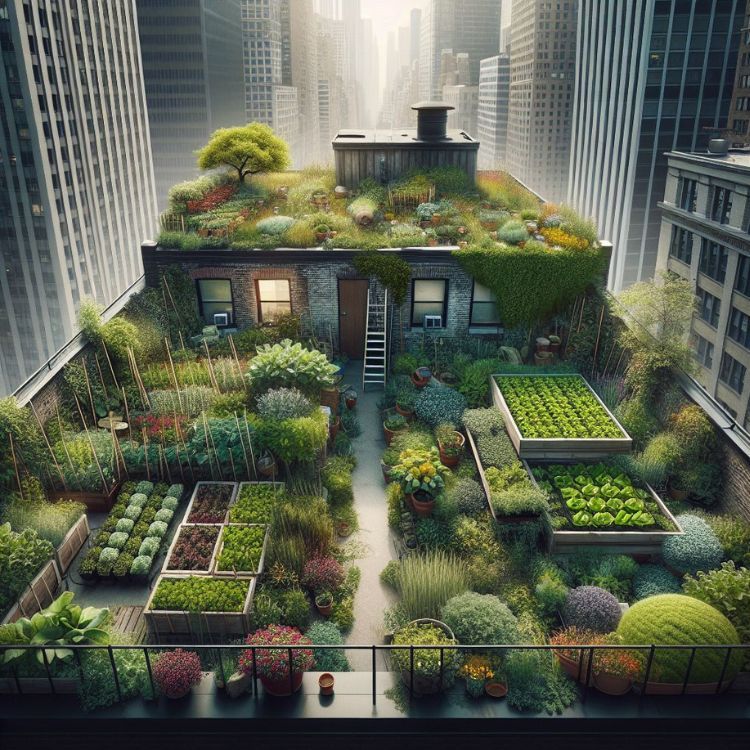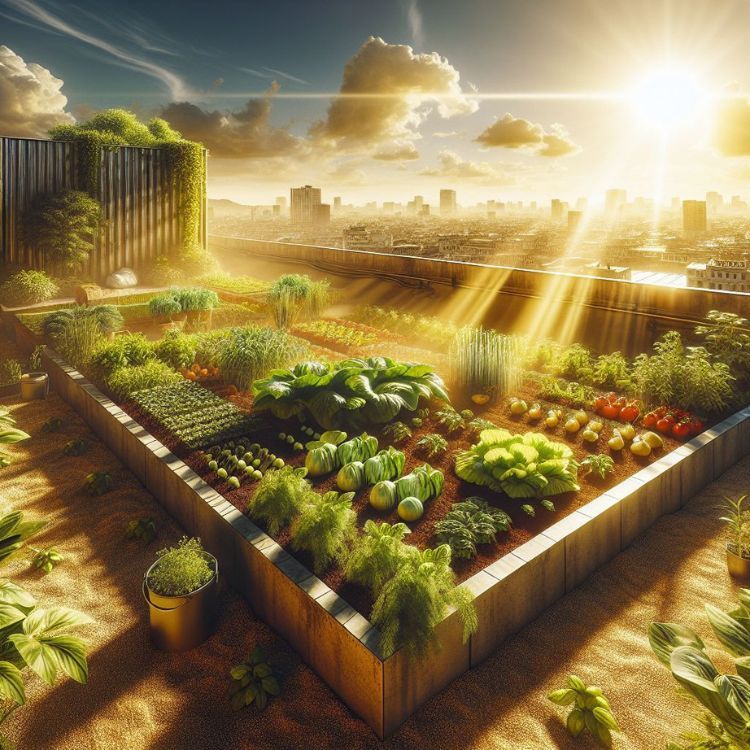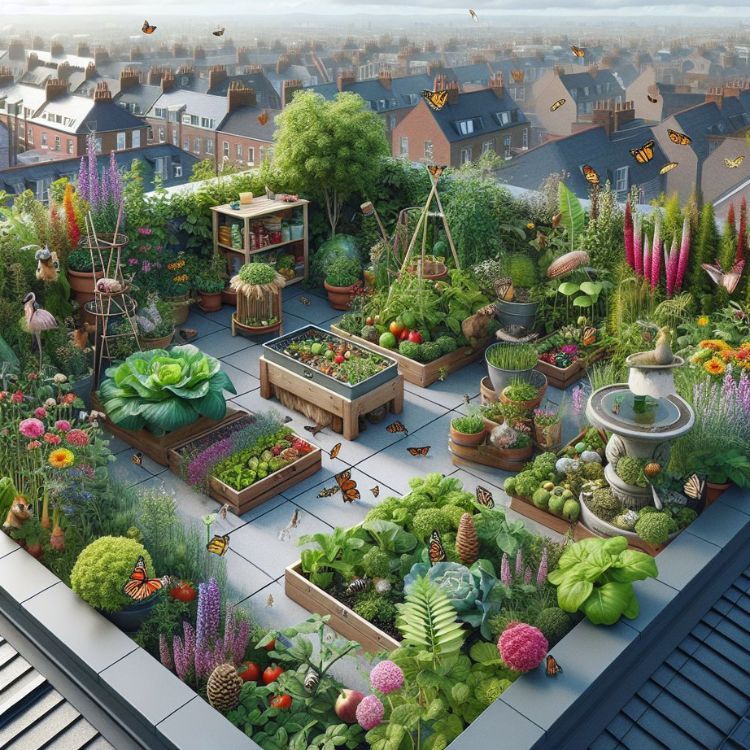
Key Takeaways
-
Space constraints in the city are no match for the innovative techniques of urban gardening.
-
Vertical gardening and container gardening are effective methods for maximizing limited urban spaces.
-
Choosing the right tools and plants that suit the urban environment is crucial for a successful city garden.
-
Understanding and optimizing the use of resources like soil and sunlight is key to urban gardening success.
-
Community gardens offer not only a space to grow plants but also to build connections and support local ecosystems.
Shattering Illusions: Thriving Gardens in Urban Jungles
When we think of gardens, we often picture sprawling plots of land bathed in sunlight. But let’s turn that image on its head. City dwellers, I’m here to tell you that lush, productive gardens are not just a rural privilege. With a little creativity and the right know-how, your balcony, rooftop, or even that tiny patch of sunlight in your living room can become a green sanctuary. Let’s break down those barriers and show you how to make the most of your urban space.
Fact vs. Fiction: Space Constraints Won’t Stop You
Most importantly, let’s debunk the biggest myth: “I don’t have enough space to garden.” That’s simply not true. Even the smallest spaces can yield impressive results. Here’s what you need to know:
-
Assess your available space and consider the possibilities – balconies, windowsills, and even walls can be transformed into garden spots.
-
Choose plants that thrive in small spaces and don’t require deep soil to grow, such as herbs, leafy greens, and some root vegetables.
-
Make use of vertical space with hanging baskets, wall planters, or trellises for climbing plants.
Remember, it’s not about the amount of space you have, but how you use it. So, let’s get creative and make every inch count.
Garden in the Sky: High-Rise Horticulture
Think your high-rise apartment disqualifies you from gardening? Think again. Rooftop gardens are not just for those with penthouse suites. With the right approach, any rooftop can be converted into a thriving green space.
Start by checking with your building management about the feasibility of a rooftop garden. Safety and structural integrity are paramount. Once you have the green light, here’s how to create your high-altitude oasis:
-
Opt for lightweight containers and soil mixes to ensure your garden is not too heavy for the roof.
-
Choose wind and sun-tolerant plants that can handle the exposed conditions of a rooftop environment.
-
Install a simple drip irrigation system to keep your plants hydrated without the need for daily watering.
With these steps, you’ll be well on your way to sipping your morning coffee surrounded by a garden, high above the hustle and bustle of the city streets. For more insights, read about debunking common garden myths.
Toolbox Talk: Picking the Right Gear for City Green Spaces
Having the right tools is essential for any gardener, but when you’re working with limited space, choosing tools that are both effective and space-saving is crucial. Let’s look at what you’ll need:
Compact Powerhouses: Tools That Fit Small Spaces
Here are some must-haves for the urban gardener’s toolkit:
-
A sturdy, compact hand trowel for planting and potting – it’s the Swiss Army knife of gardening tools.
-
Pruning shears to keep your plants in shape and encourage growth.
-
A collapsible watering can or a water bottle with a punctured cap for a makeshift watering solution.
These tools won’t take up much room but will make a big difference in the care and maintenance of your city garden.
Smart Watering: Systems for the Urban Gardener
Watering might seem like a simple task, but when you’re dealing with a city garden, it’s all about efficiency. A smart watering system will save you time and ensure your plants get the hydration they need without waste.
Consider a self-watering planter or a DIY drip irrigation system using recycled bottles. These solutions not only conserve water but also make your gardening routine more manageable.
Picking Pollution Fighters: Best Plants for City Air
City air can be tough on plants, but some are up to the challenge. These pollution fighters are not only resilient, they actively help purify the air around them. Spider plants, snake plants, and peace lilies are all excellent choices that can thrive indoors and require minimal maintenance.
For outdoor spaces, consider larger plants like hedges or small trees that can create a barrier against dust and pollutants. Hardy varieties such as juniper, boxwood, and certain maples can withstand urban conditions and make your garden a clean-air haven.
Edibles Anywhere: Vegetables for Your Balcony or Windowsill
You don’t need a traditional garden to grow your own food. Many vegetables and herbs love the container life and can produce bountiful harvests right from your balcony or windowsill. Herbs like basil, cilantro, and mint are perfect for small pots and can be used fresh in your cooking.
Tomatoes, peppers, and strawberries can also be grown in hanging baskets or window boxes, giving you fresh, homegrown produce without setting foot outside your door. The key is to choose dwarf or bush varieties that are bred to perform well in confined spaces.
Soil and Sunlight: Maximizing City Gardening Resources

Good soil and adequate sunlight are the cornerstones of any successful garden, but in the city, these can be in short supply. Let’s tackle how to get the most out of what you have.
Composition is Key: Building Healthy Urban Soil
Urban soil can be poor in nutrients and structure, but that’s nothing a bit of compost can’t fix. Creating your own compost with kitchen scraps and yard waste not only reduces your environmental footprint, it enriches your soil with the nutrients plants crave.
If composting isn’t an option, look for high-quality potting mix and consider adding slow-release fertilizers to give your plants a steady supply of nutrients. Remember, healthy soil equals healthy plants, so invest in the groundwork of your garden.
Light it Right: Understanding Sun Exposure in an Urban Setting
Sunlight can be elusive in the city, with tall buildings casting long shadows. But even in these conditions, plants can prosper. Observe the patterns of light and shade in your space throughout the day, and choose plants that match those conditions.
For shady balconies, go for shade-loving plants like ferns or hostas. If you have a sunnier spot, sun-worshippers like lavender or rosemary will be happy. And if natural light is really scarce, grow lights can provide a full spectrum of light to keep your indoor garden thriving.
Creative Spaces: Alternative Gardening Methods
When traditional gardening isn’t an option, it’s time to think outside the box—or rather, inside different kinds of boxes, pots, and even bags. For those living in urban areas, exploring quick survival garden solutions can be a perfect way to start your city gardening adventure.
Vertical Victory: Climbing the Walls with Your Garden
Vertical gardening is a real space-saver and can turn a blank wall or fence into a lush tapestry of greenery. Use trellises, wall planters, or even repurposed pallets to create vertical gardens. Climbing plants like ivy, clematis, or even vining vegetables like cucumbers and peas are ideal for these setups.
But it’s not just about going upwards—think about hanging gardens from the ceiling or attaching planters to railings. The sky’s the limit when you start to see your space in three dimensions.
Community Counts: Sharing Spaces for a Greener City
Community gardens are a fantastic way to get more green space in the city. They’re places where you can grow your own plants while also contributing to a larger, shared garden. Most importantly, they foster a sense of community and connection to nature.
To get involved, reach out to local gardening groups or your city council. If there isn’t a community garden nearby, why not start one? With a group of like-minded neighbors, you can transform vacant lots or underused land into vibrant green spaces.
Interaction: Inviting Wildlife and Building Ecosystems

City gardens aren’t just for people—they can be vital havens for wildlife, too. Creating a garden that attracts birds, bees, and butterflies not only adds life and beauty to your space, it helps support local ecosystems.
Urban Pollinators: Attracting Bees and Butterflies
To attract pollinators, plant a variety of flowers that bloom at different times throughout the growing season. Flowers like lavender, echinacea, and marigolds are great for bees, while butterflies prefer plants with flat, open blooms like zinnias and cosmos.
Remember to provide a source of water for wildlife and avoid using pesticides, which can harm beneficial insects and birds. With a little planning, your city garden can become a bustling hub of nature’s activity.
In the heart of the city, amidst the concrete and steel, your garden can be a mini oasis, a testament to the resilience of nature, and a source of pride and sustenance. It’s not just about debunking myths; it’s about reimagining what’s possible and creating something beautiful and productive against all odds. Now, let’s get those hands dirty and those gardens flourishing!
Frequently Asked Questions (FAQ)
As an urban gardener, you’re bound to have questions. Let’s tackle some of the most common ones, providing you with clear, actionable answers.
Can I garden if I don’t have a yard?
Absolutely! Lack of a yard is no obstacle for the determined gardener. Balconies, windowsills, and even indoor spaces can become lush gardens. Container gardening is your best friend here, allowing you to grow a variety of plants in pots, boxes, or even hanging baskets. With the right approach, you can create a verdant retreat in the smallest of spaces.
What are some low-maintenance plants for city gardening?
City life is busy, so you might be looking for plants that don’t require daily attention. Succulents, such as aloe vera and jade plants, are incredibly forgiving and perfect for busy lifestyles. Herbs like rosemary and thyme are hardy, require little care, and can add a fragrant touch to your garden. For outdoor spaces, consider perennials like daylilies or hostas, which come back year after year with minimal fuss. If you’re interested in more tips for a resilient garden, you might want to explore drought-resistant veggies to further enhance your urban oasis.
How do I protect my garden from urban pollution?
Urban pollution is a concern, but there are steps you can take to protect your garden. Firstly, choose plants that are known for their resilience to pollution, like conifers and evergreens. Additionally, regular watering and wiping down leaves can help remove dust and pollutants. Creating physical barriers with taller plants or trellises can also shield your more delicate plants from harsh environmental elements.
Is it possible to grow edibles in limited sunlight?
Yes, you can grow edibles even if you don’t have full sunlight. Leafy greens like spinach, kale, and lettuce can thrive in partial shade. Root vegetables such as carrots and potatoes also do well with less sun. Be sure to choose varieties that are suited for lower light conditions and monitor their growth to ensure they’re getting enough light to produce a good yield.
How can I create a community garden in my area?
Creating a community garden is a fantastic way to cultivate plants and community spirit. Start by gathering a group of interested neighbors to share the workload and benefits. Then, seek permission from local authorities to use the land. Once you have a location, plan the layout, decide on communal and individual plots, and don’t forget to set some ground rules. With everyone pitching in, your community garden can become a reality.
By now, it should be clear that urban gardening is not just a possibility but a vibrant, thriving practice that’s reshaping the way we think about city living. With every plant you nurture, you’re contributing to a greener, more sustainable urban environment. So, embrace the challenge, let your creativity bloom, and watch as your concrete jungle transforms into a verdant paradise. Happy gardening!
Urban survival gardening is a growing trend among city dwellers looking to increase their self-sufficiency and food security. In the concrete jungle, space is at a premium, but with creativity and the right techniques, you can cultivate a thriving garden on rooftops, balconies, and even windowsills. Key to success is choosing the right crops that can handle the unique challenges of urban environments, such as limited space and soil quality. For instance, heat-resistant okra varieties are perfect for rooftops exposed to the full force of the sun, while herbs can be easily grown indoors on a sunny windowsill.






